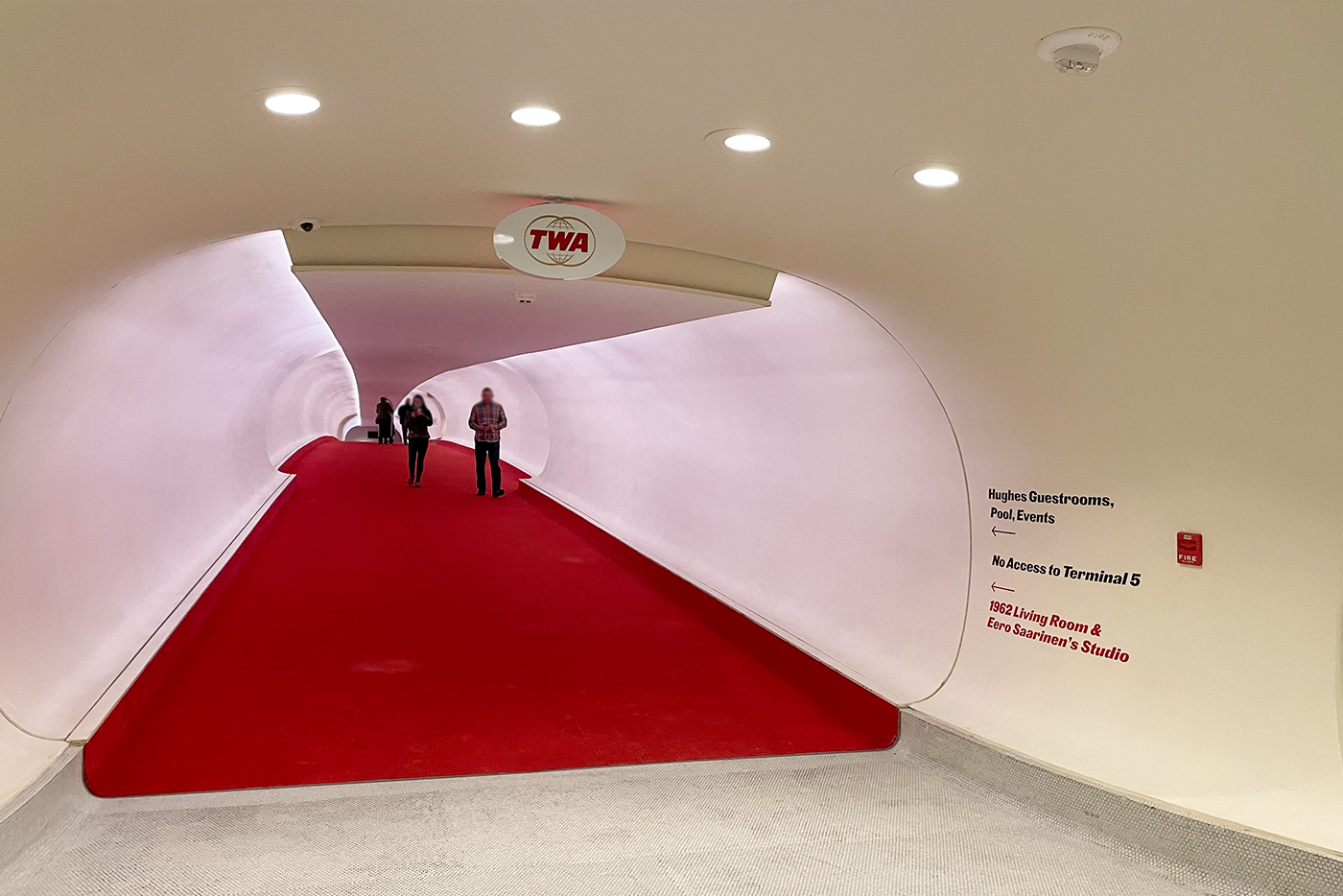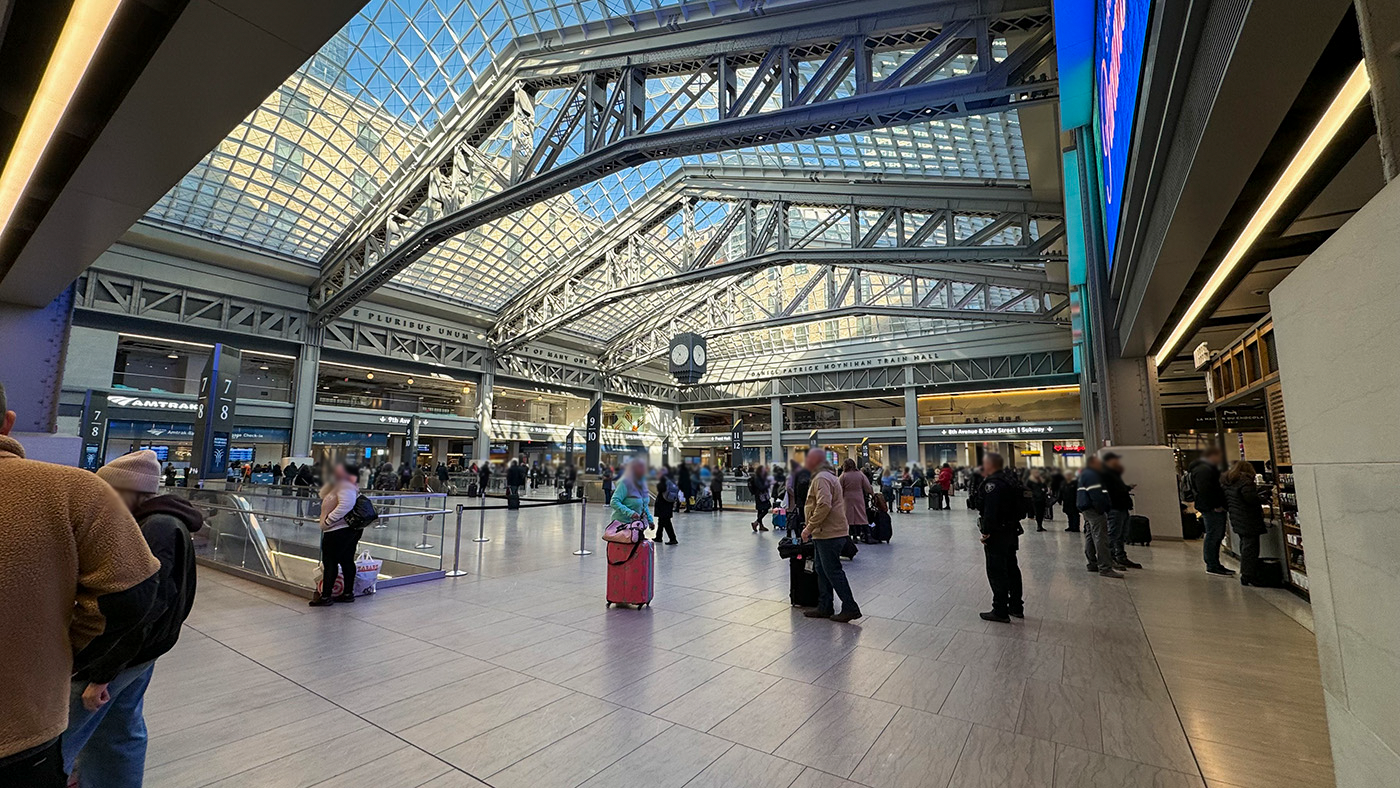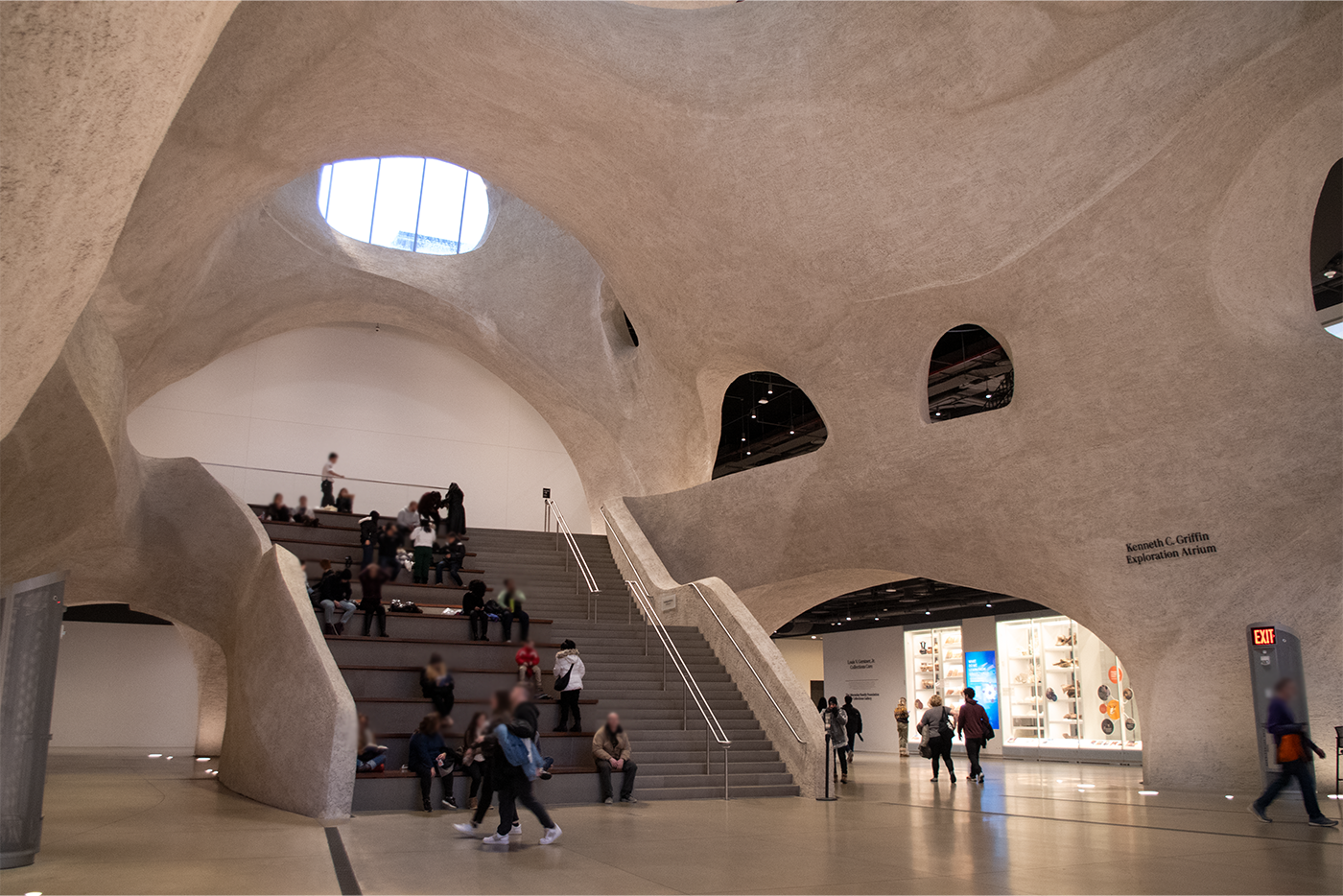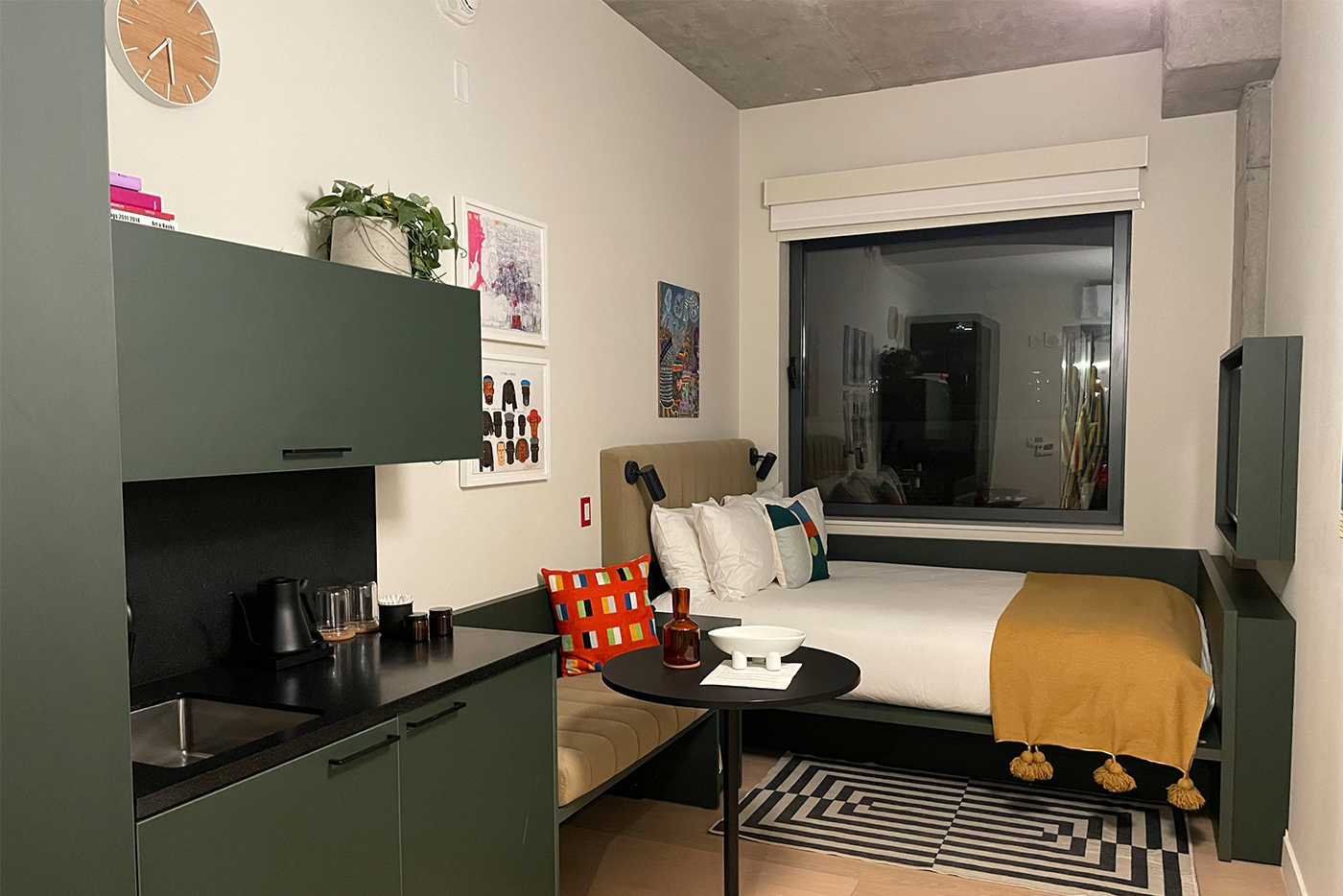We visited New York. This article introduces some of the places I visited during my trip.
TWA Hotel
Yoshida: The first place I visited upon arriving in New York was the TWA Hotel, directly connected to JFK International Airport. Originally an airport terminal, the building has been repurposed as a hotel.
TWA Hotel at New Yorkʼs JFK Airport
MCR and MORSE Development have reignited the magic of Eero Saarinenʼs landmark 1962 TWA Flight Center at JFK Airport, restoring and reimagining it as a first-class hotel.
This building, designed by Eero Saarinen, opened as an airport in 1962. The exterior of the TWA Hotel, with its silhouette resembling a large bird, symbolizes flight.

Upon entering, you are immediately drawn into the expansive space. The curves from the entrance create a natural sense of openness, making the space feel very pleasant. The lighting is beautifully done, with brighter areas around the counters and timetables, and dimmer areas in the walkways and resting areas, creating a nice contrast. Although the timetables are no longer in use, they remain as a nostalgic touch, flipping through pages and evoking the past. It felt like stepping onto a movie set.


From the central hall, the counters split to the left and right, now serving as the hotelʼs check-in counter and café space. In the past, these counters were used for baggage check-in and flight check-in. The café features Saarinenʼs Tulip Chairs, which, with their single pedestal support, create a clean look even in a crowded setting.

In the 1950s, the aviation industry was fiercely competitive, and strong differentiation strategies were essential. This led to the incorporation of striking corporate colors and memorable designs in the architecture. The hallway leading to the boarding gates also uses the corporate colors, with a curved pathway enhancing the anticipation for the upcoming journey. Now, this hallway leads to a room displaying information about the architecture and interior of the TWA Hotel. Although I could only stay for about an hour due to other commitments, itʼs a place where I could easily spend an entire day.


Historic Train Stations
Ogawa: Just like the beautiful and classic architecture of the TWA Hotel, New York City has many historic buildings. I visited two of New Yorkʼs representative train stations.
The first is Grand Central Terminal, which opened in 1913. There were plans to demolish it at one point, but it remains a major station in New York today. Despite being over 100 years old, it is incredibly well-maintained.

The ceiling, depicting constellations, is a distinctive feature, though it was once stained with tobacco tar and nicotine. The current clean state is the result of a 12-year restoration, with a small section of the stained ceiling left untouched to show visitors how dirty it once was. The stark contrast is astonishing.


I also recommend experiencing the Whispering Gallery. Although it looks like a regular hallway, if you stand at one end and speak towards the pillar, your voice will travel along the arch of the ceiling and be heard by someone standing at the opposite pillar. Itʼs a fascinating experience.

The second place I visited is the newly opened Moynihan Train Hall, a historic building renovation project that cost $1.6 billion. Itʼs part of the old James Farley Post Office building. Unlike Grand Central Terminal, Moynihan Train Hall has a fully glass ceiling, creating a bright and open space with natural light. The geometric glass layout, combined with the old steel structures, brings a sense of newness within a classic framework.
The signs in Japanese stations are often in Gothic typeface, but the signs in Moynihan Train Hall use a serif typeface, blending harmoniously with the buildingʼs atmosphere.


The post office is still in operation, and you can see its pre-renovation state. The detailed decorations on the walls and desks give it a different impression from the station.

Museum Dedicated to Design
Yoshida: The Cooper Hewitt, Smithsonian Design Museum specializes in historical and contemporary design. During our visit, there was an exhibition by stage designer Es Devlin, known for her work on Olympic ceremonies, NFL Super Bowl halftime shows, and U2 stadium tours.
An Atlas of Es Devlin | Cooper Hewitt, Smithsonian Design Museum
An Atlas of Es Devlin is the first monographic museum exhibition dedicated to British artist and stage designer Es Devlin (born 1971), who is renowned for work that transforms audiences.
An Atlas of Es Devlin | Cooper Hewitt, Smithsonian Design Museum
The exhibition begins with a projection onto notebook-like objects placed on a table. Moving from a room resembling a workshop to an area displaying numerous works, you get a sense of spatial and temporal expansion. Devlinʼs works often involve direct audience participation, making the exhibition space itself enjoyable.


You can see her thought process through texts, visuals, rough sketches, paper models, and scale models. Her abstract spaces are designed for the audience to project their emotions and memories. Each scale model is like a sculpture, showcasing meticulous and delicate craftsmanship.


New Wing of the Natural History Museum
Yoshida: The American Museum of Natural History is one of New Yorkʼs iconic institutions, often remembered for the large whale model hanging from the ceiling. The new building, the Richard Gilder Center, was designed by Studio Gang.
Gilder Center for Science, Education, and Innovation | AMNH
Spectacular architecture designed to spark your curiosity. New exhibitions and immersive experiences that reveal natureʼs hidden realms. A soaring space that connects to all the Museum has to offer.
The organic, cave-like space connects the museumʼs 10 buildings, enhancing circulation within the museum. Various galleries, cut out organically, naturally come into view, piquing curiosity.
The exhibition spaces are dimly lit to allow focused viewing of the exhibits, but the central area of the Gilder Center is an atrium flooded with natural light, creating a striking contrast that enhances the excitement of moving between exhibits.


These organic walls were crafted by hand using a technique called shotcrete, invented by Carl Akeley, a naturalist at the museum in the 1900s, where concrete is sprayed directly onto rebar.

The Gilder Centerʼs design allows it to blend seamlessly with the surrounding historic buildings. The buildingʼs height matches the older museum buildings, and the granite texture of the facade harmonizes with the surrounding stone structures.
Hudson Yards
Ogawa: Hudson Yards is a new area born from a large-scale urban redevelopment project. Previously a rail yard, advances in technology made it possible to build underground tracks, creating new spots on the expansive ground above and on the decommissioned elevated railway, attracting attention. Some rail yards remain along the Hudson River, preserving its former state.

Hudson Yards features parks and outdoor facilities like the High Line, the Vessel, and Little Island. Unfortunately, in January, the extreme cold made it unsafe to enter these areas due to icy conditions. Therefore, Iʼll introduce two interesting indoor facilities.
Edge New York is the highest sky deck in New York City, located about 335 meters up, offering a 360° view of the city. The glass panels on the sides are tilted outward, giving a thrilling view downwards. Some sections of the floor are also glass, adding to the excitement.


The journey to the observation deck provides a history of Hudson Yards and explains how the skyscraper "30 Hudson Yards," where Edge is located, impacts the urban environment. The exhibits are very engaging.

The second place is Pier57, located across from Little Island, known for its architecture by Heatherwick. Originally a terminal for ships and cargo, it is now a multi-purpose facility operated by Google. Although we couldnʼt enter, the rooftop park with grass offers a great view of Little Island. The ground floor has a food court featuring young chefs from diverse backgrounds who might otherwise have fewer opportunities.
A Reimagined Pier 57 New Food Hall and Community Spaces
A Reimagined Pier 57 New Food Hall and Community Spaces


Beyond the food court is a common area where Google employees were having meetings. It would be nice to work in such a scenic environment. While the hot chocolate was delicious in the cold, I recommend visiting New Yorkʼs outdoor facilities in warmer weather.

Hotel in Brooklyn
Yoshida: During this business trip, I stayed at various hotels, but the one that left the biggest impression was Penny Williamsburg in Brooklyn.
The Penny Williamsburg | Boutique Hotel in Brooklyn New York
In Brooklynʼs lively arts hub, The Penny Williamsburg offers cozy comforts with kichenettes, pour-over coffee, & additional amenities for a pleasant stay.
The Penny Williamsburg | Boutique Hotel in Brooklyn New York (penny-hotel.com)
PENNY collaborates with local non-profits LAND Gallery and Pure Vision Arts to display artwork by New Yorkers with developmental disabilities. Hereʼs what my room looked like.

Most hotels have information filed in a folder on the desk, but at PENNY, this information is organized on a corkboard, from room service details to Wi-Fi passwords and local area maps. The graphics are attractive, and each one has a unique style while maintaining a cohesive look.

Everything in the room, from shampoo to hair dryer bags, had the hotel logo, giving a custom feel. The graphics on the signs within the hotel and the emergency evacuation maps were also carefully designed.

Although I didnʼt get the chance to use it, there is a restaurant floor above the guest rooms. The hotelʼs identity is reflected even in the tableware, with each table napkin color different, likely sparking enjoyable conversations. The outdoor area was closed due to snow, but on a sunny


Other ActivitiesAll Activities
WorksAll Works








